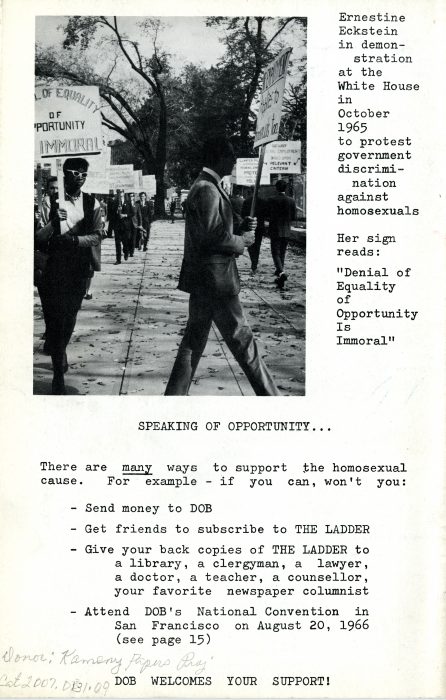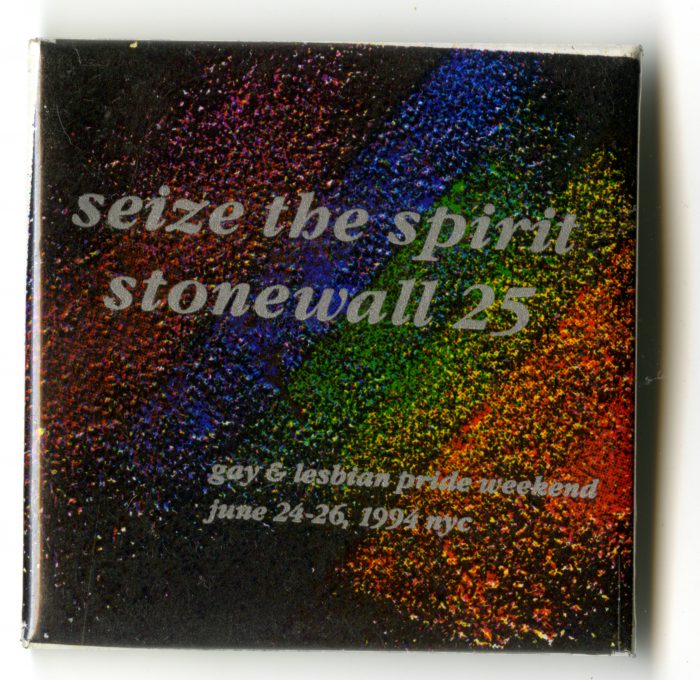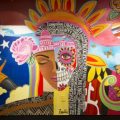From our house to the White House: Celebrating Pride
Madeleine Wyand-Geise introduces us to the latest display in an ongoing collaboration between the Smithsonian and the White House to curate temporary exhibitions exploring American diversity. LGBTQ+ Pride Month is celebrated each June to coincide with the first Pride March held in New York City on June 28, 1970, one year after the Stonewall Uprising.

In celebration of Pride Month, the White House and the National Museum of American History collaborated on a 28-object display celebrating inspirational events, moments and people from the LGBTQ+ community. Illuminated by rainbow-colored lights from the Pride flag, the temporary exhibition in the White House’s Ground Floor Corridor in the Executive Residence serves as a sometimes poignant, sometimes heroic, but ultimately triumphant reminder of the community’s contributions and struggle for civil rights. The colors progress from red to violet, from west to east, as visitors move between objects of contemplation and celebration.
Although the corridor is unavailable to the public, non-dignitaries can learn about the objects on the Smithsonian’s Learning Lab site. The display will remain at the White House until July 6. Fortunately for us, the internet is forever.
Matthew Shephard
The exhibit begins with personal mementos from Matthew Shepard, a college student at who died of severe injuries following a vicious attack in October 1998 when he was a student at the University of Wyoming, Laramie. His killing made headlines around the world and resulted in an outpouring of grief and anger that people channeled into poetry, songs and musical compositions, a major motion picture, The Matthew Shepard Story, and at least two plays, The Laramie Project and The Laramie Project: Ten Years Later. His parents donated a collection of his objects to the Smithsonian.

Harvey Milk
These next objects commemorate the life and activism of Harvey Milk. Milk was a visionary civil and human rights leader who became one of the first openly gay elected officials in the United States when he won a seat on the San Francisco Board of Supervisors in 1977. Milk’s unprecedented loud and unapologetic proclamation of his authenticity as an openly gay candidate for public office, and his subsequent election gave never-before experienced hope to LGBTQ+ people everywhere at a time when the community was encountering widespread hostility and discrimination. His career was tragically cut short when he was assassinated nearly a year after taking office. (From the Milk Foundation’s official bio.)



Equality
The exhibit continues with objects centered on the fight for LGBTQ+ equality. For decades, the LGBTQ+ community and its allies fought for marriage equality. Until the Supreme Court established the right to same-sex marriage in 2015 with Obergefell v. Hodges, individuals such as David DeFelice and Paul Scherbak were blocked from marrying. David and Paul became some of the first same-sex couples to marry in California after the state struck down its ban on same-sex marriage in 2008. Their wedding cake topper, shown in the exhibit, demonstrates the ongoing fight for equality, justice and love for LGBTQ individuals.

Pride Celebrations
From solemnity to celebratory, the exhibit moves to objects highlighting Pride celebrations. Pride events celebrate the LGBTQ+ community. Celebrations of social and self acceptance, achievements, legal rights, and pride are the center of the often-outdoors, worldwide events. Further down the hall, the exhibit pays homage to Pride’s origins with the Stonewall Uprising. Here, a rainbow ribbon necklace, transgender flag, “Trans and Proud” button, two pride fans, Black Pride postcard, and flyer for a South Asian Lesbian and Gay Association (SALGA) Pride event demonstrate the range of intersectional identities celebrated during Pride Month.






Serenity
Objects in this case symbolize differing paths LGBTQ+ women took – one privately, and one publicly – to living, loving, and sharing their lives.
Rose Cleveland, President Grover Cleveland’s sister, served the role of White House hostess until his marriage in 1886. The recent exhibition of First Lady portraits at the National Portrait Gallery included a likeness of her with label text that described a relationship she had with Evangeline Marrs Simpson, a wealthy married woman who eventually became her life partner. They were living together by 1910 in Bagni de Lucca, located in the Tuscany region of Italy, until Rose’s death in 1918. Rose and Evangeline are buried side by side in Italy and their love letters, which are housed in the Whipple Collection in the Minnesota Historical Society, were published in 2019.

Activism
Pride Month simultaneously celebrates the progress towards LGBTQ+ equality and reminds us of the rights still unwon. The objects in this narrative demonstrate the resilience and determination of the many individuals who fought to live freely and authentically. Many of the objects in this group are from the collection of Frank Kameny, an early movement leader who spent decades fighting against the federal government’s anti-LGBTQ+ employment policies.



The “Homosexuals for Equality Button,” “Gay is Good” buttons, “Go-Go Mattachine” button, come from the collection of Frank Kameny, one of the founders of the gay rights movement.




The Ladder magazine was published by The Daughters of Bilitis, the New York chapter of the first national organization for lesbians. Barbara Gittings, a prolific organizer and activist, established the group. Other popular LGBTQ news sources included The Homosexual Citizen and the Mattachine Review magazine.
The Stonewall Uprising
Objects in this display recognize the origins of Pride celebrations: the Stonewall Uprisings. In June 1969, police raided the Stonewall Inn, a popular gay bar in New York City’s Greenwich Village. The bar’s patrons, including transgender and gender non- conforming people, lesbians, and gay men, fought back, sparking several days of protests. A year later, to mark the anniversary of the uprising, thousands of people took to the streets for the Christopher Street Liberation Day Parade, which is widely regarded as the first Pride celebration.


Mark Segal Papers
Series 3
Box 23
Folder 11
Flyer; Christopher Street Gay Liberation Day, New York City, New York; 1970 June 28
The “Seize the Spirit of Stonewall 25” button commemorates the 25th anniversary of the raid’s resulting protests. For the 50th anniversary of the Stonewall Uprising in 2019, New York City paid homage to the original protests and became the center of World Pride.

Lesbian, Gay, Bisexual, Transgender (LGBT) Collection
1146
Box 113
Pin; “Seize the Spirit Stonewall 25”, New York City, New York; 1994 June 24-26
The AIDS Epidemic
The final portion of the exhibit centers around the AIDS Epidemic and its devastating toll on the LGBTQ+ community. The AIDS Epidemic began to take hold in the early 1980s. While HIV affects Americans from all walks of life, the epidemic continues to disproportionately impact certain members of the LGBTQ+ community. Individuals with AIDS not only struggled to find medical care and treatments, but also endured the menacing effects of socialized stigma surrounding the disease.
The NAMES Project AIDS Memorial Quilt grew out of a group of devoted family, friends, and partners of those lost to AIDS and help others understand the devastating impact of the disease.


For more objects in this exhibition, visit the Smithsonian Learning Lab.
Posted: 28 June 2021






